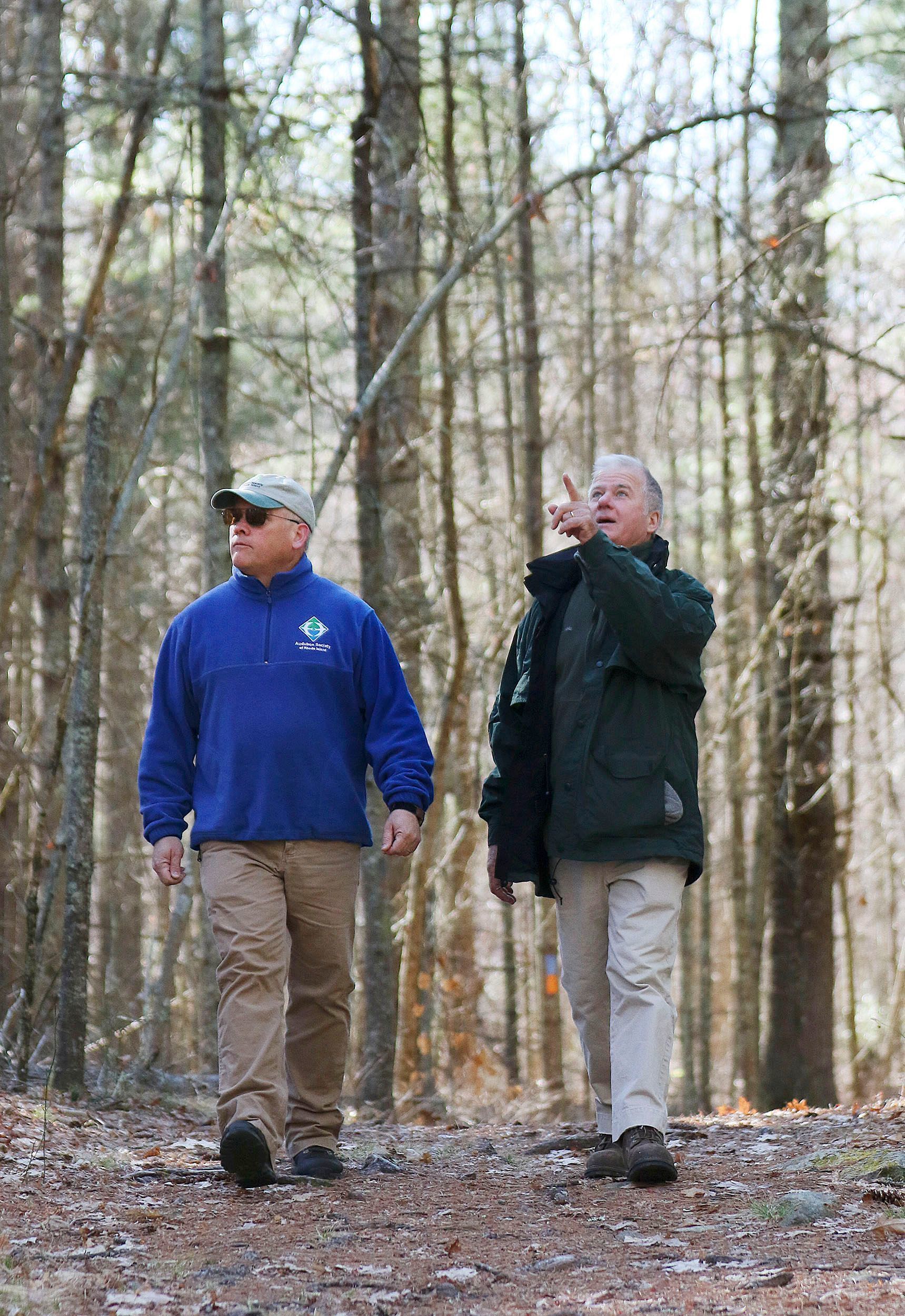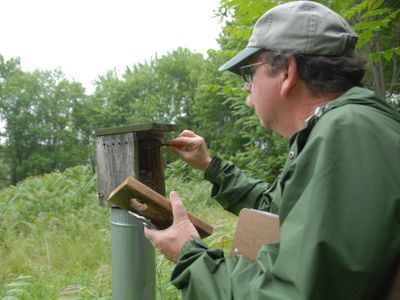
Audubon Executive Director Larry Taft (right) and Audubon Senior Director of Conservation Scott Ruhren monitoring the property at Fisherville Brook Wildlife Refuge. Credit: Glenn Osmundson
Published March 5, 2021
Where Science Begins
Keeping an Eye on Nature
By Todd McLeish
Several times each week from May through August, Cindy Dibble visits three sites in Narragansett and South Kingstown where Osprey are known to nest, and during each visit she watches the birds and makes notes about what she sees. She documents when the birds arrive on migration, when they mate, when they begin incubating their eggs, and when the fledglings make their first flight, among other milestones. All of her observations are then uploaded to Audubon’s Osprey Monitoring Program website.
“I’m just so fascinated by this majestic bird,” said Dibble, a retired special education teacher who has been an Osprey monitor for three years. “It’s time-consuming, but it’s also fun. And when you’re monitoring the same nest for several years, you get attached to the birds and you start to worry about them.”
Dibble is one of nearly 100 volunteers who monitored about 200 nest sites last year for a program that was started by the Rhode Island Department of Environmental Management in 1977 and has been managed by Audubon since 2010. All of the data collected by the volunteers is compiled into an annual report that is shared with researchers to better understand the fluctuating populations of this once-rare bird.
The Osprey Monitoring Program is one of many science-based research and monitoring efforts undertaken by Audubon staff and volunteers each year that are designed to gather information about wildlife and their habitats.
Despite Audubon’s long-term commitment to science, its positions and practices are sometimes challenged by those with different motives, like those who continue to deny that the climate is changing and those changes are largely caused by human activities.
“We want to continue to be the organization that people turn to and trust, with staff who have experience and know what they’re talking about,” Taft said. “And we’re trying to be more and more proactive on how we conduct our monitoring and the active roll we play in conservation, not just for feel-good reasons, but to have a real and lasting impact in protecting birds and wildlife.”
When developing policy positions, for instance, Audubon staff members refer to research papers, reports and other documents and then verify their accuracy before drawing conclusions.
“A transect in the woods designed to count how many salamanders there are can help students document natural science facts and train them how to read data and analyze issues for themselves,” Taft said. “It’s a way to discover the importance of monitoring nature. And we hope that activities like these, led by our education staff, will inspire some budding scientists.”
Audubon’s commitment to science is most evident in its environmental monitoring and stewardship activities. Its wildlife refuges have actively supported natural science research for decades. Through numerous legacy projects, like the Kingston Wildlife Research Station (which got its start in 1956) and long-term bird and rare plant monitoring at sites around the state, Audubon has collected data and collaborated with a wide variety of partners to evaluate population declines, make management recommendations, and identify trends that could lead to environmental protection.
According to Scott Ruhren, Audubon’s senior director of conservation, some trees and shrubs were cut to open up the canopy and allow a new generation of native trees and shrubs to grow. “Rabbit researchers in the Northeast know what kind of habitat and plant types are needed to attract New England cottontails, and observational studies have identified the preferred habitat of certain birds,” he said. “We know that when forests close in, you lose some bird species.
“We also left the cut material on the ground to provide cover for animals. That messiness is exactly what the animals need,” Ruhren added. “Based on research, we know a messy forest reduces herbivory by deer because they have a hard time getting over the debris. Which means that vulnerable plants might have a better chance to flourish in the face of the typically heavy influence of deer in the Northeast.”
Since the restoration began seven years ago, Audubon’s bird expert Laura Carberry, the manager of the Fisherville Brook Refuge in Exeter, has been conducting breeding bird surveys at Eppley each year to determine whether bird populations have changed in the desired way. And they have. The next step in the project is to further improve the habitat by monitoring and removing invasive species.
Among the targeted birds are Pine Warbler, Black-throated Green Warbler, Red-eyed Vireo, Scarlet Tanager, Wood Thrush, Eastern Wood-pewee, Pileated Woodpecker and Barred Owl. All are experiencing declines in their global populations and require large tracts of contiguous forest for breeding.
Three demonstration sites have been identified – a woodlot in Foster managed by the Rhode Island Forest Conservators Organization, the Norman Bird Sanctuary in Middletown, and a private landowner in Richmond – where forest management techniques that support birds can be showcased. At each site, Ruhren surveys plants and bird habitat characteristics and Carberry surveys birds before and after the management steps are taken to highlight how bird populations change.
“It’s all about showing the foresters what good management looks like,” Sayles said. “Foresters don’t typically focus on songbirds, so the key is to get them to look for important habitat features the birds need and to make recommendations based on that. It’s to get them to use birds as another important informational tool in their forest management plans.”
The second component of the program involves enrolling private landowners interested in managing their forested lands. Ruhren and Carberry have already conducted surveys at about 25 properties in two years and made recommendations to foresters developing management plans for those sites.
“It’s a no-brainer, as far as I’m concerned,” Ruhren said. “If you’re interested in maintaining your forest well, then most of what you’re likely to do is going to help the birds."
The science behind the Providence Stormwater Innovation Center at Roger Williams Park, which Audubon leads in partnership with The Nature Conservancy, Providence Parks Department and Roger Williams Park Conservancy, is equally varied and robust.
Over 40 projects have been installed in the Park to filter contaminants and treat stormwater runoff. Rain gardens have been constructed to treat stormwater by pooling water on the surface and allowing filtering and settling of suspended sediment as the water flows into the ground. Buffer plantings and bioswales have also been installed to treat stormwater and improve water quality, and a reduction in impervious surfaces – pavement – also aids the process. A key element of the project is monitoring water quality in the Park’s ponds as well as when water enters and leaves the Park to learn if the infrastructure improvements have had the desired effect. All of this work is being coordinated by Audubon staff member, Ryan Kopp.
“Audubon has always participated in and relied on science, and turned to research by experts to help inform our management practices, our stance in policy, and the kind of materials we offer in our educational programs,” concluded Taft. “That commitment to science continues with the Stormwater Innovation Center. Per our new strategic plan, science is front and center at Audubon. It’s part of who we are, and always will be.”























